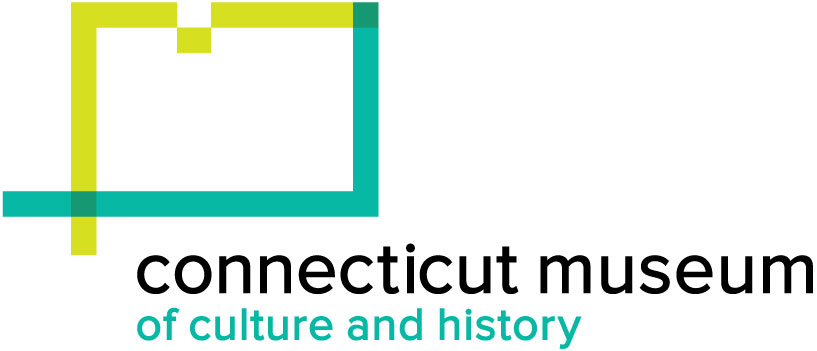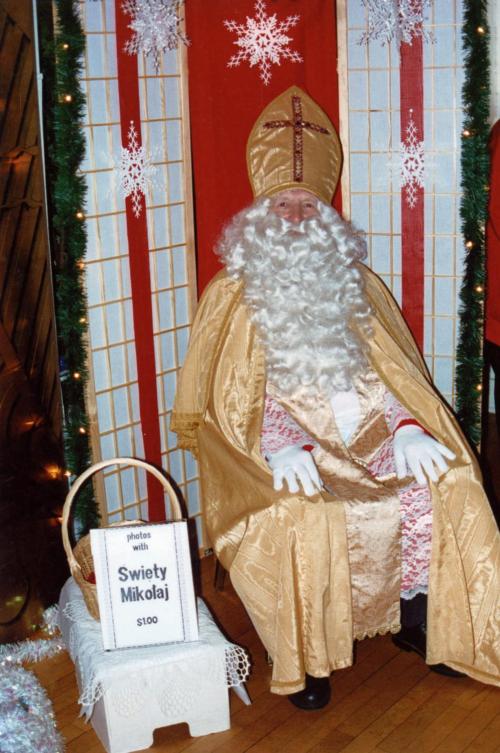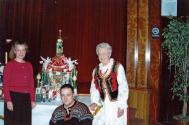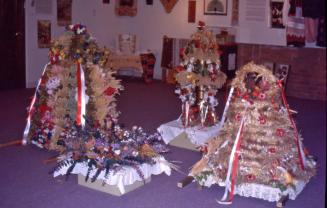Szopka Festival, 2000
SubjectPortrait of
Cliff Archie
SubjectPortrait of
Marek Czarnecki
(Polish-American)
SubjectPortrait of
Lottie Pozniak
SubjectPortrait of
Lynne Williamson
SubjectPortrait of
Maria K. Brodowicz
(Polish, 1932 - 2018)
Date2000 November
Mediumphotographs
ClassificationsGraphics
Credit LineConnecticut Cultural Heritage Arts Program collections
CopyrightIn Copyright
Object number2015.196.443.14-.28
DescriptionPhotographs from the Szopka Festival at the Polish National Home.
(.14) Image of Cliff Archie, a member of the Polish Cultural Club, dressed as Święty Mikołaj (Saint Nicholas) at the Szopka Festival.
(.15) Image of Marek Czarnecki and Lottie Pozniak, who is a teacher, judge, and organizer of the Festival, standing next to szopki on display.
(.16) Image of Lottie Pozniak, who was a teacher, judge, and organizer of the Festival, standing next to szopki on display.
(.17) Image of Lynne Williamson (CCHAP Director), Marek Czarnecki, and Lottie Pozniak next to a szopka on display.
(.18-.26) Images of szopki that were made by students and displayed at the Festival at the Polish National Home.
(.27-.28) Images of Maria Brodowicz and Jadwiga Czarnecka setting up a Christmas tree with Polish ornaments that they made for the CCHAP community exhibit "Polonia w Connecticut" at the Institute for Community Research.
NotesSubject Note: In a continuation of the living tradition of creating nativity scenes from humble and re-used materials, the Polish Cultural Club of Greater Hartford has sponsored the szopka festival, an annual November contest and festival held for many years (until 2020) at the Polish National Home in Hartford. Children from several Greater Hartford schools create their versions of the Szopka Krakowska, designing elaborate mangers to mimic the domes, towers, balconies, and roofs of local buildings in Krakow. They use recycled materials such as juice bottles, aluminum foil, cardboard boxes, and toy figures. The tradition of making elaborate manger scenes depicting the birth of Jesus at Christmas draws from the centuries-old ancient practice of staging nativity plays in village crèches carrying a szopka as a scene or small stage. The word szopka means shed, and refers to the humble stable where Jesus was born. The Szopka Festival sponsored by the Polish Cultural Club of Greater Hartford has been held at the Polish National Home every Thanksgiving weekend for several decades.(.14) Image of Cliff Archie, a member of the Polish Cultural Club, dressed as Święty Mikołaj (Saint Nicholas) at the Szopka Festival.
(.15) Image of Marek Czarnecki and Lottie Pozniak, who is a teacher, judge, and organizer of the Festival, standing next to szopki on display.
(.16) Image of Lottie Pozniak, who was a teacher, judge, and organizer of the Festival, standing next to szopki on display.
(.17) Image of Lynne Williamson (CCHAP Director), Marek Czarnecki, and Lottie Pozniak next to a szopka on display.
(.18-.26) Images of szopki that were made by students and displayed at the Festival at the Polish National Home.
(.27-.28) Images of Maria Brodowicz and Jadwiga Czarnecka setting up a Christmas tree with Polish ornaments that they made for the CCHAP community exhibit "Polonia w Connecticut" at the Institute for Community Research.
Subject Note: The Polish Cultural Club of Greater Hartford “was established in 1976 to preserve and promote the history, culture, and customs of Poland with fellow Americans." An active organization that has held many meetings at the Polish National Home on Charter Oak Avenue in Hartford, the Club sponsors lectures, seasonal celebrations such as Wigilia at Christmas time, the annual szopka festival, and gives scholarships and support to Scouts groups. The Club collaborates with the Polish Foundation and the Central Connecticut State University Polish Studies Department and Library in New Britain.
Subject Note: The Polish community comprises nearly 10% of the state’s population, settling here during the late 19th and early 20th centuries when New England’s industrial growth made jobs plentiful in mills and factories. Thousands from rural areas of Poland left behind difficult political and economic circumstances to work in America. A similar movement of people took place in the 1980s, and Polish newcomers continue to arrive, bringing a very different sense of “Polishness” and cultural tastes from the older immigrants. Uprooted from their homeland and all that is familiar, these new Americans have found refuge in maintaining traditional customs, beliefs, foods, language, and joining together in fraternal, cultural, political, academic, and veterans societies. Parish churches fill a very important function as centers for social organization and cultural unity as well as providing spiritual and emotional comfort. The Polish saying Co kraj, to obyczaj explains that in the American Polish communities called Polonia some of the old practices change to fit new circumstances, or disappear altogether among recent generations.
The seasonal round of celebrations, festivals, holidays, along with the activities and art forms associated with them, connect Polish Americans to a dimension of beauty, meaning, spirituality, and heritage which they remember from the past but also practice today. In Connecticut works of art and everyday objects for use in the home are still made by hand in traditional Polish styles. Older objects from Poland are often redecorated with materials found here, and the process of creating and using these pieces shows an active expression of identity, not a mere recreation of old folk art forms.
New Britain, the center of Polonia in Connecticut, has a longstanding language school and folk dance group. Central Connecticut State University hosts the Polish and Polish American Studies Program and Library – one of only two such programs in the country. Broad Street is a thriving center of Polish commerce and activity, and has hosted an annual festival since 2012 called “Little Poland.” The festival is held in late April to mark Poland’s Constitution Day, a celebration of the democracy enjoyed by Americans under their country’s Constitution. In Hartford, the historically Polish neighborhood around Wyllys St/Popieluszko Court/Charter Oak Avenue included SS Cyril and Methodius Church, the Church School, the Polish National Home, and several businesses.
Community celebrations and seasonal holidays often follow the liturgical calendar of the Church. Christmas is celebrated with Pasterka, the midnight mass of the shepherds when koledy, holy carols, are sung. On the Feast of Epiphany, chalk is blessed in the church and used to inscribe door lintels with K + M + B, the initials of the three kings. At Easter, baskets of food for the Easter breakfast are blessed in the church. Processions mark Corpus Christi, the Feast of the Blessed Sacrament (and a ritual to ensure good crops) in June. In the late summer, harvest festivals called Dożynki featuring an open-air or church Mass with a blessing and distribution of bread, folk dancing, craft and food vendors are held in New Britain, Bristol, and Bridgeport/Ansonia. Harvest ornaments, large structures of wheat sheafs decorated with flowers and ribbons, are made and displayed by community artists. On All Souls Day in November Polish families visit the graves of their relatives, decorating them with candles and flowers after an outdoor mass.
One of the Polish community’s important artists, iconographer Marek Czarnecki from Bristol “writes” images of saints that convey essential theological and biographical information and embody the presence of the holy ones depicted. A respected community scholar and teacher, he also restores church statues and lectures on Polish folk traditions such as szopka-making.
Subject Note: "Polonia w Connecticut: Polish American Traditional Arts in Connecticut," an exhibition describing the arts and customs of this large community in Connecticut, was developed by CCHAP in collaboration with members of the Polish community, and was displayed in the gallery of the Institute for Community Research (ICR) from December 7, 2000 to May 2001. The project aimed to bring forward the enduring traditions of Polish American communities in Connecticut by conducting fieldwork in these communities, by collecting art works which express community traditions which still are practiced, by presenting an exhibition and related programming to the public and for schoolchildren, and by developing closer ties with the Polish community as ICR was situated in the heart of Hartford’s historic Polish neighborhood. Project partners included the Polish National Home, Ss. Cyril and Methodius Church and School, the Polish Cultural Club of Greater Hartford, the Polish Studies Department at Central Connecticut State University, and a number of community-based local Polish artists and collectors. Marek Czarnecki, an accomplished Byzantine iconographer and scholar from the Bristol Polish community, served as co-curator and gave a gallery talk on March 3, 2001. The project produced a catalogue of exhibit texts and information in both English and Polish. At the exhibit opening, performances were given by the Gwiazdeczki Dancers, a longstanding folk dance group from Saints Cyril and Methodius School and Parish, Hartford, and Wladyslaw Furtak, a singer, storyteller and woodcarver from the Gorale region of Poland who resides in Ansonia. Project funders included the Edward T. and Ann C. Roberts Foundation, the Connecticut Commission on the Arts, the National Endowment for the Arts, and the Polish Studies Dept. of CCSU.
The exhibit was timed to coincide with the annual "szopka contest" in late November when students from schools in New Britain and Hartford would create szopki - traditional Polish nativity scenes - then bring them to Hartford's Polish National Home on Charter Oak Avenue where a panel of judges awards prizes for excellence and creativity during the annual szopka festival. Some of these szopki were included in the CCHAP exhibit. Traditional art forms such as papercutting (wycinanki), painted eggs (pisanki), icons, embroidery, harvest ornaments, Christmas ornaments, and folk costumes all made by Connecticut Poles were featured, and the exhibit also included handmade altars and figures made for devotional use in people's homes, a common Polish practice. The exhibit demonstrated the beauty, usefulness, and continuation of traditional arts specific to the large Polish-American community in Connecticut, while also noting the ways traditions become altered in a new world setting.
Biographical Note: Maria K Brodowicz (1932-2018), a resident of Wethersfield CT, was deeply committed to her Polish heritage and involved in many aspects of community life. Born in Poland, her early life was disrupted by the Second World War and forced exile. With other members of her family, Maria eventually immigrated to the US in 1954. She was a member of many Polish-American organizations including the Polish American Congress, Ss Cyril and Methodius Church in Hartford and the Rosary Society, the Paderewski Choir, and the Polish Cultural Club of Greater Hartford where she often participated in and managed cultural events. Maria was a skilled artist in forms such as sewing, home decorations, and foodways, and she knew many folk traditions and practices, sharing her knowledge with the community. She received the Cavalier Cross Order of Merit Republic of Poland from the president of Poland as well as the Siberian Exiles Cross, and was named Immigrant of the Year in 2017 at a ceremony led by the Secretary of the State at the State Capitol. As her obituary states, “Most special and important to her was her work with the Polish Scouting Organization (ZHP), she was a founding member of the scouts in Hartford and president of the Friends of Polish Scouts (KPH) for thirteen years. As a lifelong scout herself, she achieved the highest rank, and as a leader, was devoted to mentoring the young women in her care.” Maria was instrumental in assisting with CCHAP’s exhibit “Polonia w Connecticut” by creating decorations for the Christmas section of the exhibit and also creating an Easter Table as it would be made and decorated in a Polish American home.
Biographical Note: Jadwiga Czarnecka is a longtime Bristol CT resident and member of the Bristol and Greater Hartford Polish communities. Born in Poland, her early life was disrupted by the Second World War and forced exile in Siberia before she was able to immigrate to the US. She has devoted her life to her family and her church, St Stanislaus Kostka in Bristol, serving in many capacities including singing in the choir, organizing and cooking food for the annual festival, and contributing her knowledge of Polish traditions and heritage. She also participated in and helped to organize many events as a member of the Polish Cultural Club of Greater Hartford, including annual celebrations such as the Wigilia dinner and the Szopka Festival. Her son, iconographer and community scholar Marek Czarnecki, has joined her in this community work. Along with her longtime friend Maria Brodowicz, Pani Czarnecka assisted with CCHAP’s exhibit “Polonia w Connecticut” by creating decorations for the Christmas section of the exhibit and also creating an Easter Table as it would be made and decorated in a Polish American home.
Additional audio, video, and/or photographic materials exist in the archive relating to this community and these events.
Cataloging Note: This project was made possible in part by the Institute of Museum and Library Services MA-245929-OMS-20.
Status
Not on view2000-2001 December-March
Graciela Quiñones-Rodriguez
2004 February 21
2008 September 6




























